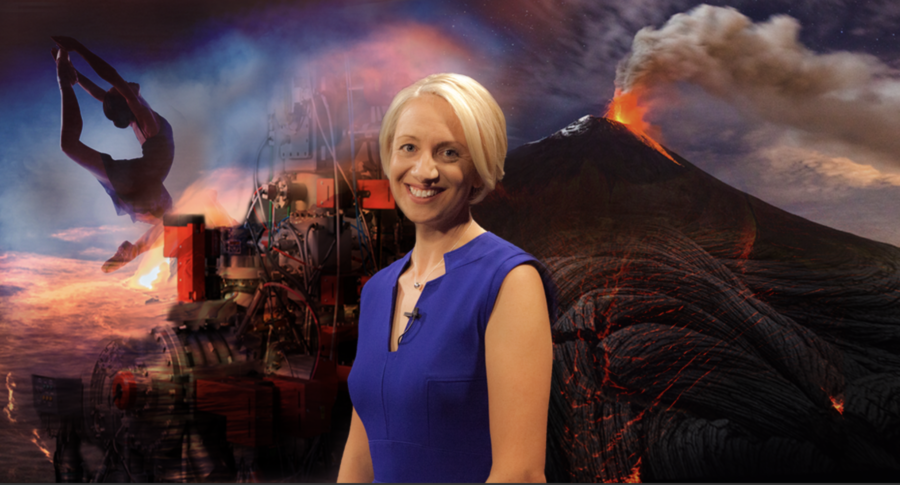Christy Till: My name is Christy Till, and I’m a geologist and assistant professor in ASU’s School of Earth and Space Exploration I lead a multidisciplinary lab that studies magma, molten rock that forms beneath the Earth’s surface and how it forms on Earth and other planets, as well as the lead-up to volcanic eruptions.
But before I studied magma and lava flows, my career focused on a different kind of flow: ballet. For five years before I went to college, I was a professional dancer in two world-renowned companies. My life as a ballet dancer was very fulfilling, but also very exhausting. During the weekdays there were classes and rehearsals. During the nights and weekends were performances. And altogether my salary was below that of minimum wage.
But you do it because you love it. Because you’re an artist. Because you can’t imagine doing anything else. But slowly over time that changed for me. A change in artistic direction, watching fellow dancers get injured and then fired, working through injuries of my own, and wanting to have a stable career that lasted past the age of 30 all slowly led me to make the choice to leave the dance world and go to college. In ballet, a big leap is called a grand jeté, and certainly leaving the dance world and going to college to pursue a degree in science felt like a grand jeté.
It was hard to leave behind something that I loved so much, that I’d been doing since the age of 4, but ultimately was not serving me anymore and move into this big, scary unknown. In college I worked very hard but I lacked confidence. But ballet had taught me to give my dreams everything that I had no matter what any doubting mentor said, or how many rejection slips I received—and trust me, there were a lot. But I learned that it was important to me to give it my all. And that that meant that I could live with the outcome no matter what it was because I knew I gave it my best shot.
It was during this time as an undergraduate that I found myself standing on a mountainside at geology field camp looking at a rock formation. And the professor had described this as being deposited during a cold mud flow. But as I looked at it, I realized that I disagreed with him. I actually thought that it had been deposited hot, during a volcanic corruption.
This was a eureka moment for me. Because not only had I made my first scientific discovery, but I gained my first little bit of confidence as a scientist. It was in that moment that I first felt like a geologist. And travel forward here in time, and here I am as a professor now, and I get to do all sorts of amazing things like make magma in the lab.
When you think of magma chambers you probably think of red hot boiling goo. But actually we as scientists have learned that that’s not a very good model. Magma chambers are actually just a little bit of that hot red liquid, but they’re mostly crystals that form as the magma chamber cools. And those crystals grow rings, or zones, much like a tree grows rings. And tree rings tell us about the environment that a tree was growing in, and those crystal rings tell us about the environment in the magma chamber at the time the crystal was growing. These crystals are then erupted and deposited on the surface as ash or lava flows, and we can go sample them and bring them back to ASU where we can analyze those crystals with specialized equipment.
We analyze very tiny parts of those crystals that are only one one-hundredth the thickness of a human hair. And that allows us to reconstruct the events in the magma chamber leading up to eruption. And so we can hope to through these kinds of studies one day build a volcano early warning system, much like we have for earthquakes.
When you think of geology and time, you probably think of millions and billions of years. But one of the most startling things that we have learned is that these time scales and magmatic processes occur on the scale of a human lifetime, in only hundreds or tens of years. Some of our research at Yellowstone National Park actually suggests that these magmatic processes happen in months or less. Months or less? Oh no! Does that mean there’s gonna be a volcanic eruption at Yellowstone in months? Isn’t that one of those super volcanos that kills people?
Well, as a scientist I’m here to allay your concerns. There is no imminent signs of eruption at Yellowstone. And, Yellowstone actually has many more small eruptions than it has large ones. So it’s much more likely if it were to erupt again in the future it would have one of the small elections, a small lava flow of cubic kilometer or less. And we also have many amazing scientists and instruments that monitor the volcano every day and would let us know if there were signs of an imminent eruption.
Although it might seem unlikely, I credit ballet as excellent preparation for being a geologist and now a professor. Ballet is about trying again, and again, and again until you prevail. And today for every scientific discovery, there is just as many frustrating days in the lab. For every funded grant there is just as many if not more rejected proposals. But I am happy to be here every day giving it my best shot. And one of the great many joys of my job is that I get to help students of all ages and backgrounds have moments of scientific and self-discovery, just like mine that day on the mountainside.
